British Strawberry Scones
British tea time just got a serious upgrade! Forget plain scones—British strawberry scones add a fruity, buttery twist to the classic teatime treat. Their light, crumbly texture and fresh strawberries make them the perfect companion to a good cup of tea. Serve them with strawberry jam and clotted cream for the ultimate indulgence.
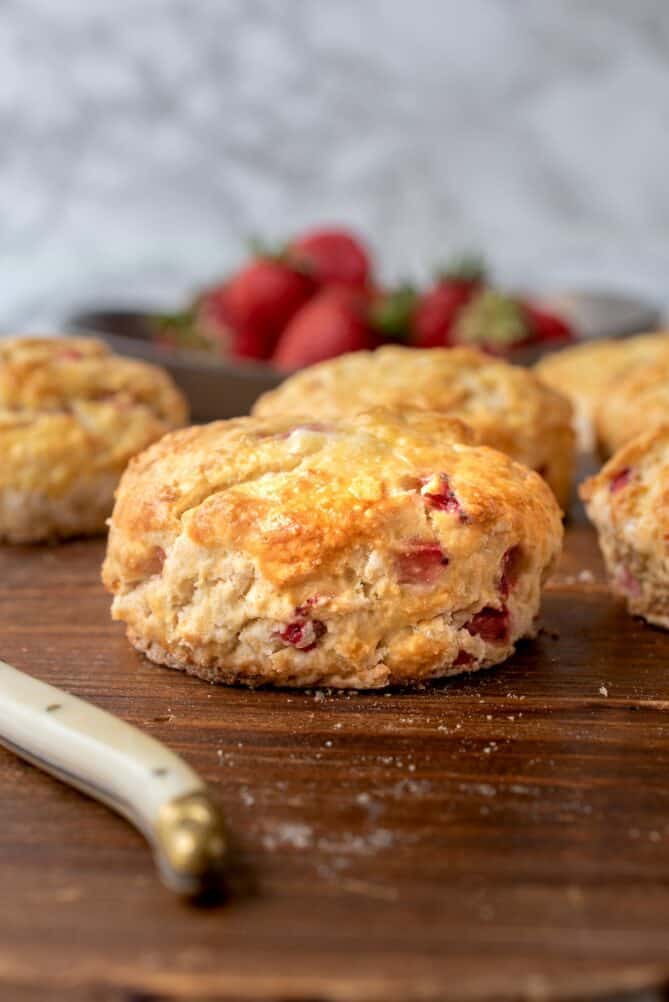
Table of contents
- Ingredients
- Afternoon Tea or Cream Tea Treat
- What is Clotted Cream?
- When Do you Eat British Scones?
- The Thickness of English Scones
- English Scone Varieties
- Sweet Variations
- Savory Variations
- Key Tips for Perfect Scone Dough
- A few things to keep in mind when making the dough to achieve perfect scones:
- Baking the Best Scones
- Using Freeze-Dried Strawberries
- Storing English Scones
- How to Pronounce Scone
I first published these scones here in 2020. They are made in the classic English scone style—round, tall, and without glaze—these fresh strawberry scones are the perfect treat, especially during strawberry season. Enjoy them as a snack or a breakfast delight!
Ingredients
- Flour
- Baking powder
- Salt
- Butter
- Milk
- Sugar
- Strawberries
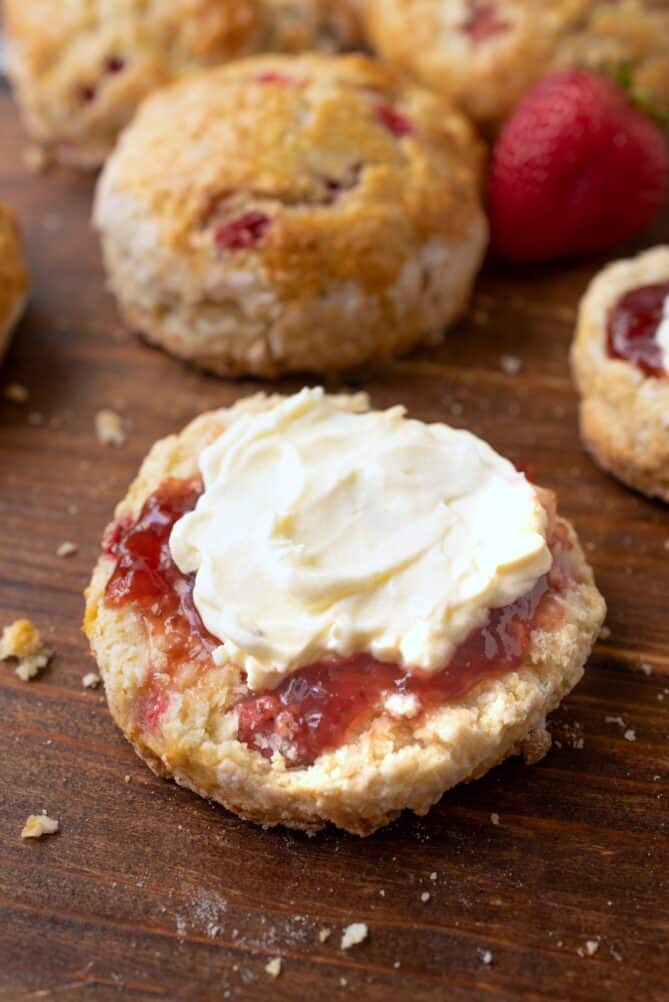
Afternoon Tea or Cream Tea Treat
You will typically find scones served for afternoon tea. A an elaborate affair, featuring finger (or tea) sandwiches and pastries. Cream tea, on the other hand, is a simpler version that includes only scones served with clotted cream and jam, along with a pot of tea.
What is Clotted Cream?
Clotted cream is a rich, thick, unsweetened dairy spread made by slowly heating full-fat cow’s milk until the cream rises to the surface and thickens. It is made from the finest milk from cows in Devon and Cornwall, located in the southwest of England.
When Do you Eat British Scones?
Scones can be enjoyed any time of the day—from breakfast to brunch, a mid-morning snack, or an afternoon treat with tea.
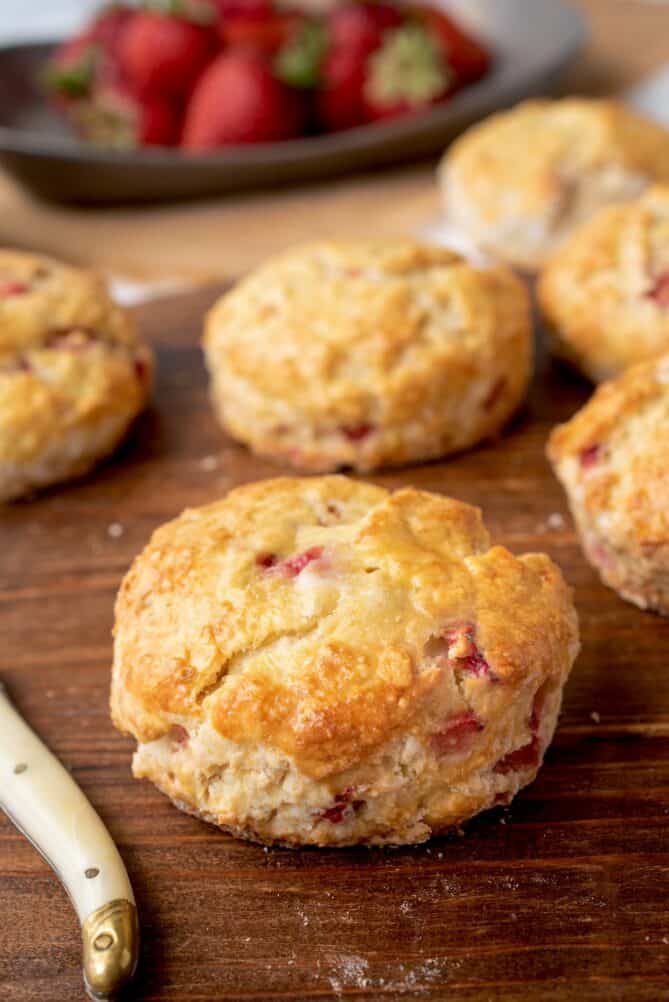
The Thickness of English Scones
While scones don’t need to rise dramatically like bread, a good scone does require some lift to achieve their signature light, tender texture rather than being dense and heavy.
The leavening in scones (usually baking powder) works in conjunction with the dough’s thickness, usually 1-inch (3 cm). Since scones don’t spread much while baking, keeping the dough on the thicker side helps them achieve their signature height. Both of these factors help to:
- Create a soft, airy crumb rather than a tough or doughy texture.
- Help the scones puff up slightly while still maintaining their classic, slightly crumbly bite.
- Ensure they don’t turn out too flat, giving them just enough height for a nice split when adding jam and clotted cream.
English Scone Varieties
English scones are incredibly versatile and all start with a basic scone recipe.—in addition to the classic plain variety, you can add just about any savory or sweet ingredients to customize them to your taste!
Sweet Variations
- Fruit Scones – Warming spices like cinnamon and nutmeg along with sweet apples and soft, sweet Medjool dates.
- Chocolate Chip Scones – A treat for chocolate lovers with melty chocolate in every bite.
- Pumpkin Scones – Fresh pumpkin, homemade pumpkin pie spice mix, and currants or raisins.
Savory Variations
- Herb & Garlic Scones – Fresh rosemary, thyme, or chives give a fragrant touch.
- Cheese Scones – Cheddar, Gruyère, or Parmesan add a rich, savory flavor.
- Bacon & Cheddar Scones – A hearty, flavorful option perfect for breakfast.
- Sun-Dried Tomato & Olive Scones – A Mediterranean-inspired take with bold flavors.
Key Tips for Perfect Scone Dough
You’re looking to achieve a soft dough—a balance of slightly sticky and slightly crumbly—while still holding together. Avoid overworking it, they will turn out dense and heavy rather than tender scones. Never use a rolling pin; handle the dough as little as possible to keep the butter from melting. The goal is to keep the butter cold and the dough light, so as the butter melts in the oven, it creates steam, causing the dough layers to separate slightly. This is what gives scones their beautiful, flaky layers.
A few things to keep in mind when making the dough to achieve perfect scones:
- Thoroughly mix the all-purpose flour mixture (flour and baking powder) well.
- Rub the cold butter between your fingers well, or use a pastry cutter/pastry blender to make sure the butter is mixed well with the flour.
- When adding the wet ingredients to the dry ingredients, only mix until they are combined. Over mixing can result in tough scones.
- You must used cold butter which helps create steam and lift the scones while baking.
- Avoid using heavy cream or double cream, as they can make the scones dense. Buttermilk can be used as an alternative, though it’s not traditional.
- Mix the dough by hand in a large bowl rather than using a food processor, which can overwork the dough.
- When cutting scones, avoid twisting the cutter, as this can lead to uneven rising—though sometimes it’s unavoidable.
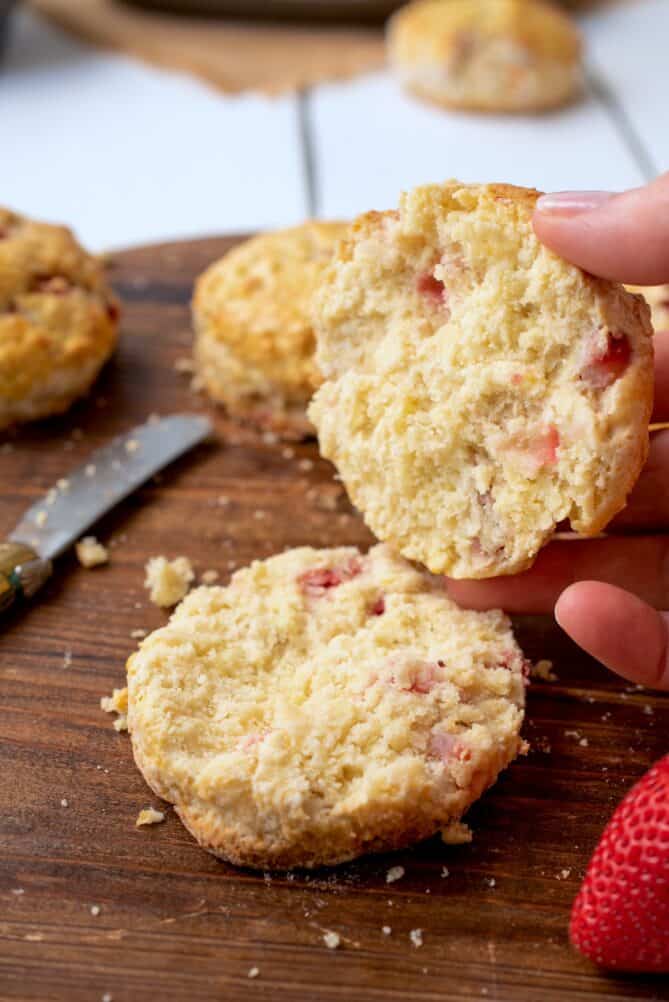
Baking the Best Scones
- Brush the tops of the scones with milk to achieve a lightly golden brown finish without the glossiness of an egg wash.
- Let them cool slightly on a wire rack before cutting to allow the crumb to set.
- Use a prepared baking sheet (baking tray) lined with parchment paper or a silicone mat to prevent sticking.
Using Freeze-Dried Strawberries
You can substitute fresh strawberries with freeze-dried when fresh are not in season.
Storing English Scones
Freshly baked scones are best enjoyed the same day, but if you need to store them, here’s how to keep them fresh:
Short-Term Storage (1–2 Days)
- Store scones in an airtight container at room temperature for up to 2 days.
- If scones contain fresh fruit, store them in the fridge to prevent spoilage.
- To refresh, warm them in a low oven (300°F/150°C) for 5–10 minutes or microwave for a few seconds.
Refrigerating Scones (3–5 Days)
- While refrigeration helps extend freshness, it can also dry scones out.
- Wrap scones tightly in plastic wrap or store them in an airtight container.
- Reheat before serving for the best texture
For Baked Scones:
- Let them cool completely, then wrap individually in plastic wrap.
- Store in a zip-top freezer bag for up to 3 months.
- Reheat frozen scones in a 350°F (175°C) oven for 10–15 minutes or until warm.
For Unbaked Scones:
- Cut and shape the dough, then freeze scones unbaked on a baking sheet.
- Once frozen, transfer them to a freezer bag and bake straight from frozen (just add a few extra minutes to the baking time).
How to Pronounce Scone
In the UK, we say ‘scon’. In the US, they pronounce it ‘skoan’.
If you’ve made these British Strawberry Scones, please leave a star rating in the recipe card. You can also leave a comment or question below.
British Strawberry Scones
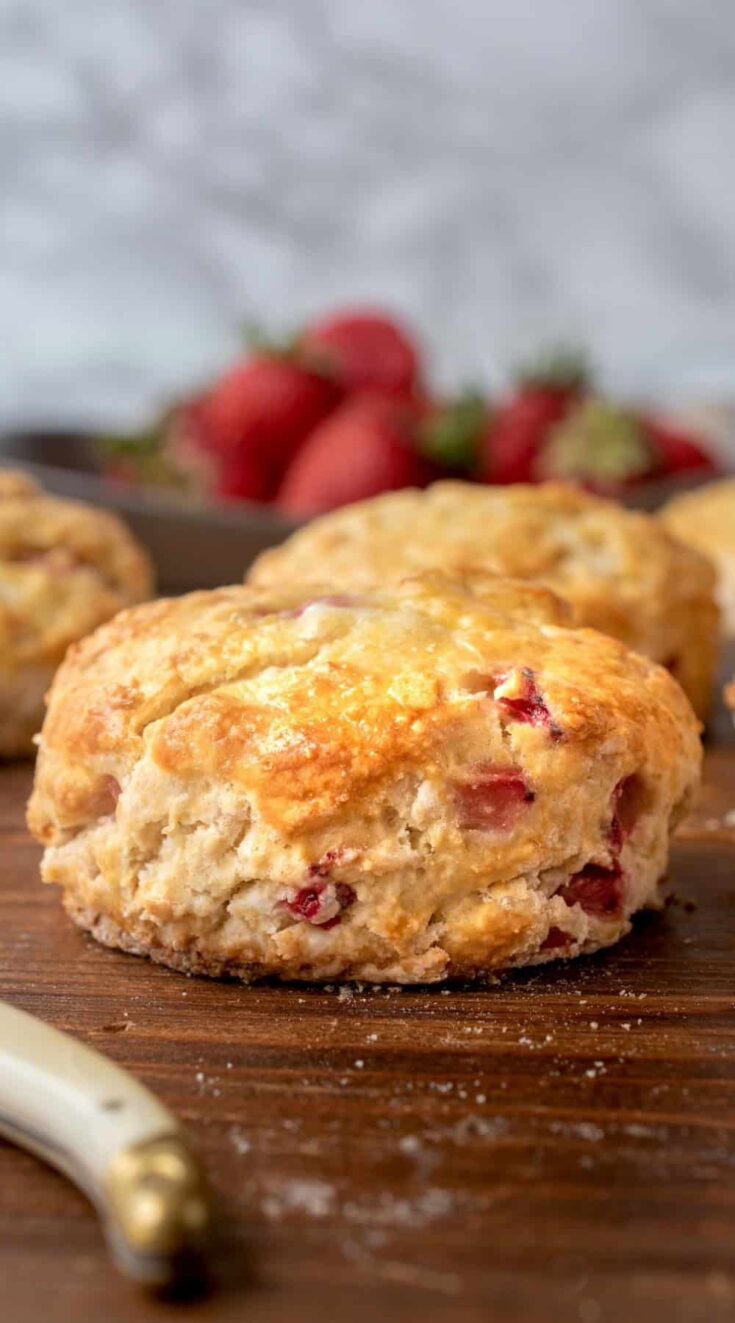
Made in the round, British style. These scones are light and fluffy with fresh strawberries.
Ingredients
- 2 cups (260 grams) all-purpose flour
- 2 teaspoons baking powder
- ½ teaspoon salt
- 5 tablespoons (2 ½ ounces/70 grams) unsalted butter, cold, cut into small pieces
- 2 large eggs, room temperature
- ¾ cup (180 ml) plus 1 teaspoon milk, room temperature
- 2 tablespoons granulated/caster sugar
- ½ cup (68 grams) fresh strawberries, chopped small
Instructions
This recipe yields 6 scones
- Preheat oven to 425°F/220°C. Cover a baking sheet/baking tray with parchment/baking paper.
- Sieve the flour, baking powder and salt into a large bowl and mix well. Add the butter and rub between your fingers until the mix resembles breadcrumbs and the butter is evenly mixing into the flour.
- In a separate bowl, whisk 1 egg into ½ of the milk. Make a well in the center of the flour and add the egg/milk, sugar and strawberries. Mix the dough lightly with a fork until it comes together adding a little more milk as you mix (you may not need it all). It should be moist, but not sticky and just holding together.
- Turn the dough onto a lightly floured cutting board. Flatten and fold the dough so the top is smooth without cracks. Shape the dough to ¾-inch (2 cm) thick round. Do not work the dough too much and do not use a rolling pin.
- Using a non-fluted 2 ½ inch (5 cm) cookie cutter, dipped in flour, cut rounds pressing straight down, do not twist. Dip the cutter into flour before each cut.
- Whisk the remaining egg with the 1 teaspoon milk and brush the tops of the scones. Bake for 15-20 minutes or until lightly golden brown.
- Remove from the oven, transfer to a wire rack to cool completely. Cover with a clean, dry towel while they cool to keep them moist.
- Storing scones: Store them in an airtight container at room temperature for up to 2 days. For longer storage, refrigerate them for up to 5 days—just warm them in the oven or toaster before serving. You can also freeze them for up to 3 months; thaw at room temp and reheat in a warm oven to refresh.
Notes
Step-by-step video:
Nutrition Information
Yield
6Serving Size
1Amount Per Serving Calories 249Total Fat 10gSaturated Fat 6gTrans Fat 0gUnsaturated Fat 3gCholesterol 27mgSodium 222mgCarbohydrates 34gFiber 1gSugar 6gProtein 5g
This nutrition calculation is provided by Nutronix that is only a guideline and not intended for any particular diet.
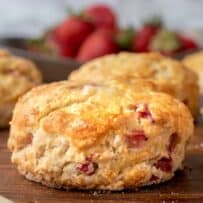
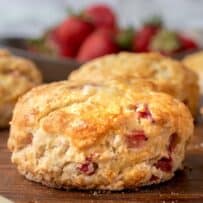

6 Comments on “British Strawberry Scones”
Is the oven you are using convection?
No, regular oven
To grate the frozen butter, I used the little hand held grater I usually use to grate hard cheese! MUCH easier and faster than a box crater and it my warm hands off the butter. Even using the largest holes, the little flakes of butter worked in very quickly: again keeping the butter as cold as possible. Also, I happen to have my dehydrator out. I diced up the strawberries and partly dehydrated them. Soft with all the flavor, just less water! They were yummy! Will definitely make again! 👍
Thank you for the great tips and I’m glad you enjoyed the scones.
Hi Janet,
I’m obsessed with Crabtree and Evelynn strawberry and clotted cream biscuits. Sadly they don’t sell them anymore and I’d like to know if this recipe will give me a similar delectable to consume. The biscuits were more of a cookie texture with dried fruit but they are called biscuits of course. Could you share your insight on how I could recreate it?
Unfortunately, I have not tried these cookies so I would not be able to help you recreate the recipe and cookie dough is different to scone dough.